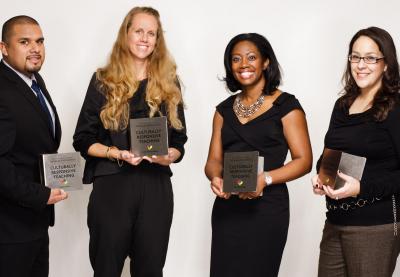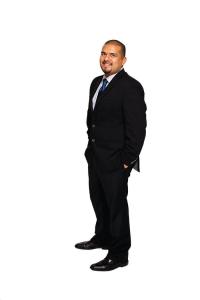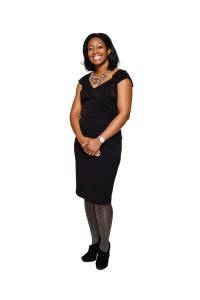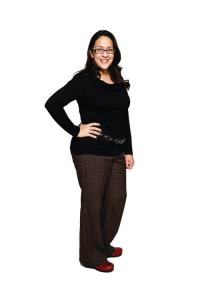Thousands of teachers each day help students from diverse racial, ethnic and cultural backgrounds. What if you could honor the best of these talented educators and help spotlight what they do?
That is what the Teaching Tolerance Award for Excellence in Culturally Responsive Teaching is all about. The first of these awards were presented at a special ceremony in December in Washington, D.C. Five honored teachers were awarded $1,000 apiece. More importantly, they were videotaped in their classrooms to help educators across the nation learn from their techniques.
“Quite simply, it’s easier to understand how to do something when you can see it being done by others,” said Teaching Tolerance Director Maureen Costello. “We hope this award not only recognizes the talented teachers reaching students from diverse backgrounds but also provides many other teachers with the tools to enhance their expertise.”
The winners of the first Teaching Tolerance Award are as diverse as their schools and their students. But all of them maximize learning by creating supportive teams of educators, students and families. They look beyond the standard touchstones in choosing learning materials. They push aside cultural stereotypes to foster strategies that work. And they take advantage of what students bring to the classroom.
Checklist for Awardees
- Builds relationships with students
- Ensures all students are included in the curriculum
- Uses flexible and heterogeneous grouping
- Gets to know students’ families
- Learns about students’ cultural backgrounds
- Varies instructional strategies
Sylvestre Arcos
Laboratory School of Finance and Technology, (Middle School 223), Bronx, N.Y.
Five years ago, Arcos helped set up a new, dual-language program at this school that emphasizes cross-cultural learning and the development of Spanish-language as well as English skills. As a result, there is a renewed respect for both languages and proficiency has improved. “We do not see them coming in with zero knowledge,” says Arcos of Spanish-dominant students. “We see them coming in with a wealth of knowledge. They are just adding a second language to their repertoire.”
Tracy Oliver-Gary
Paint Branch High School, Burtonsville, Md.
Oliver-Gary teaches open-enrollment AP history classes. Her classes are a diverse mix ofAsian, African, Latino, black and white students. She says any teacher in that situation faces a learning curve. “One thing I had to learn is that just because I’m black doesn’t mean I know how to teach black kids,” she says. And Oliver-Gary often finds herself teaching study skills as well as the curriculum. But she has learned how to access her talent for teaching in new ways. Giving her students a voice, she says, also allows her to “paint a picture of their future.”
Amber Makaiau
Kailua High School, Oahu, Hawaii
What does it mean to be Hawaiian? It’s not an easy question in this multicultural state. In 2004, Makaiau helped to write the curriculum for an innovative course in ethnic studies. Now mandatory for Hawaii ninth-graders, the course has been successful in reducing school violence and violence-related suspensions. Students see it as a success as well. In a recent essay, one student wrote, “Racism lives off the racist remarks we make toward others. I am still living and still learning. I have much ahead of me to … experience. [But] I blossomed into something more [in this class]; my growth increases every day. … I am a girl who honors all of my family names; I am a proud leader and I am Hawaiian.”
Soñia Galaviz
Endeavor Elementary School, Nampa, Idaho
Galaviz’s school serves families with the lowest socioeconomic status and the highest English-language learning needs in her district. “Building relationships,” she says, “is at the heart of my pedagogy.” She starts by visiting the homes of each of her students during the first two weeks before school to learn more about each student’s hidden strengths and how to work best with each family. In class, Galaviz supplements the curriculum with authentic materials and experiences that reflect the cultures of her Mexican-American, Asian, American Indian and white students.
Katy LaCroix (not pictured)
Logan Elementary School, Ann Arbor, Mich.
LaCroix heads up her school’s “equity team,” a group of faculty that meets throughout the year to share culturally inclusive teaching practices. One of her key strategies is to learn as much as she can about her students. She does this in part by going to lunch with them and, when she’s invited, attending important events, like church services and basketball games. “This strategy is at the heart of culturally relevant teaching,” she says. “Using what I know about my students, I can incorporate their interests, hopes and aspirations into my classroom.”
Portfolio for “And the Winners Are...”
The winners of the first Teaching Tolerance Award for Excellence in Culturally Responsive Teaching are as diverse as their schools and their students. Some are teaching the youngest students. Others are preparing young adults to enter the workforce. Some bring the richness of their own cultural backgrounds to the classroom. Others are facing cultural diversity for the first time and are learning along with their students what it means to create an inclusive and responsive environment.
But all of these educators share a commitment. They maximize learning by creating supportive teams of educators, students and families. They look beyond the standard touchstones when choosing learning materials. They push aside cultural stereotypes to foster learner-centered strategies that work. And they take advantage of what students themselves bring to the classroom.
These selected teachers have been videotaped in their classrooms as models of effective practice. This footage will be used to enhance teacher preparation and professional development on a nationwide scale.
We’d like you to meet the five teachers whose knowledge and skill makes them especially successful at meeting the needs of students from racially, ethnically and culturally diverse backgrounds. Darlene Koenig interviewed our award winners and wrote these profiles:
Soñia Galaviz: Endeavor Elementary School, Nampa, Idaho
When Soñia Galaviz began teaching kindergarten, she knew that reaching out to families made pedagogical sense with the youngest students.
“The family is the expert on this child,” she says. “I just borrow them for six hours.” So she sent out weekly newsletters and held literacy nights. But she didn’t get the connections she was seeking. She had support from the families, but wanted relationships. And so she started off her second year by planning family visits. Her colleagues weren’t sure it was a good idea.
“The school pulls children from a low-income area and housing projects, and they were concerned for my safety,” says Galaviz. “But that (excuse) never sat well with me. I did it anyway, and it literally changed the way I teach.”
Now leading a fifth-grade classroom, Galaviz continues to take two weeks at the beginning of each school year to visit students’ homes.
“I don’t have a prescribed speech or specific expectations,” she says. “I ask permission to take notes, and I ask questions.” In the course of such meetings, Galaviz might find out that a father is in jail or that a mother is sick. She might discover a student’s hidden strengths or the source of potential stress. She might learn that low attendance at evening events is due to a nighttime work schedule. In return, she makes sure that families have multiple ways to contact her. The goal, she says, is to “blur the lines between home and school.”
Galaviz also makes sure that students’ cultures are celebrated at the school. Located in the southwestern part of Idaho, Nampa draws Mexican-American families who often work in the agricultural industry. But there also are Native American, Russian and Ukrainian families. Galaviz herself is the daughter of a Mexican father and a Cherokee and English mother and “grew up a beautiful blend of Mexican and American.”
Her first challenge is often the curriculum, and she supplements it with authentic materials that reflect the community, the state and the history of westward expansion. She brings in as many speakers as she can, including a friend who sits on the local tribal council. Students also explore the history of their own families for a project that is celebrated at a potluck dinner during which all of the families meet.
Galaviz sees her approach to teaching as a responsibility.
“I don’t have the right to ask families to invest in my classroom if I’m not investing in them first,” she says. And she laughs when she says her students display very few behavior issues.
“They know I’m invested,” she says. “I know where they live!”
Tracy Oliver-Gary: Paint Branch High School, Burtonsville, Md.
Tracy Oliver-Gary was one of only two or three black teens in her advanced placement and honors classes. But she doesn’t remember it as an issue. In fact, race was rarely mentioned at all.
What she didn’t realize then, she says, is that when teachers “don’t see race,” students of color tend to blend into the dominant culture.
“I bought into the idea that to be a certain way was acceptable,” says Oliver-Gary. As a result, “I was a little invisible.” So, too, was the history of her culture. An integrated history was not part of the AP curriculum. Malcolm X was reduced to a paragraph in the history book.
At an all-women’s college, “my perceptions changed,” she says. She moved beyond a knowledge of political history to the study of social history “and how people interact with and impact each other.” Looking back, she realizes her choice of a woman’s college may have been tied to “always thinking about those people who are on the margins of society (and) giving them a voice.”
At Paint Branch High School, she teaches open-enrollment AP history classes. Open enrollment often means that some students face an AP learning curve. Tracy-Oliver says the teacher faces a learning curve as well.
“One thing I had to learn is that just because I’m black doesn’t mean I know how to teach black kids,” she says. With more diverse classrooms—both in terms of academic skill and ethnicity—Tracy-Oliver says she “had to be more intentional” in her teaching. Despite studies showing that students of color, including black and Latino students, work well in groups, for instance, she often found that “some students just really hate to work with other kids.” Her lesson plans had to be just as diverse as her students.
She has also learned that different cultures have different expectations of her.
“In some countries, the teacher has a tremendous amount of authority,” she says. “The idea that a teacher would open her doors to help is not something (those families) are used to. There are often strict boundaries.” One of her students, whose family was from Ethiopia, took four AP classes in her junior year. The student was overwhelmed, and her family didn’t like seeing her in pain. But they had faith that the school system had made the right choice in approving her schedule.
“They didn’t know they had the right” to ask for help,” says Oliver-Gary.
Her students may not look like most of those in her high school AP classes. And Oliver-Gary often finds herself teaching study skills as well as the curriculum. But she has learned how to access her talent for teaching in new ways. Giving these students a voice, she says, also allows her to “paint a picture of their future.”
Sylvestre Arcos: The Laboratory School of Finance and Technology (Middle School 223), Bronx, N.Y.
Silvestre Arcos teaches math at MS 223 in the South Bronx, but he’s not a fan of subtraction. That’s what he saw when he first surveyed the program for English-language learners at the school. The traditional, subtractive model of weaning students from their first language as they learn English had caused “a serious divide” at the school, he says. Expectations for the students were low, and—with separate teachers—they were not treated as part of the larger school community. In addition, the beauty and tradition of their language, says Arcos, was seen by others as “the language of poverty.”
“Students were embarrassed to speak Spanish, and there was social capital in denying they could speak it,” says Arcos. It was time to start seeing their skills as a plus.
In 2007, principal Ramón González asked Arcos to direct a new, dual-language program that emphasizes cross-cultural learning and the development of Spanish-language as well as English skills on the part of all students.
“We do not see them coming in with zero knowledge,” says Arcos of Spanish-dominant students. “We see them coming in with a wealth of knowledge. They are just adding a second language to their repertoire.”
As a result of the new program, there is a renewed respect for both languages. Signs around the school are in both English and Spanish. Biliteracy is a goal that adds, rather than subtracts, from students’ success.
Arcos also works to earn the trust of students’ families, hosting open houses and meetings over the summer before school begins. Families, teachers and students commit to open communication. Working with them, Arcos often sees many parallels to his own childhood. The son of Mexican immigrants who worked hard but didn’t finish middle school, he grew up in the Rio Grande Valley of Texas and attended a medical magnet school. Thanks to “an amazing high school counselor,” Arcos jumped at the chance to go to Cornell following graduation.
But Arcos still sees his culture and background as part of what makes him successful. And his intent is to instill that idea into his students, as well.
“I’ll use technology as a comparison,” he says. “You could teach word processing as a unit. Or you could integrate it into every lesson, so that it’s a medium of instruction. Here, teaching a multicultural unit doesn’t make sense. Our culture is not isolated from us. Our culture is us.”
Katy LaCroix: Logan Elementary School, Ann Arbor, Mich.
Last year, all classrooms at Logan Elementary read Sister Anne’s Hands for the school’s ongoing Read-Aloud program. The book, set in the 1960s and written by Marybeth Lorbiecki, tells the story of a young girl who has never seen anybody with dark skin until she meets her new teacher. She thinks Sister Anne is wonderful, but her appreciation deepens when she sees how her teacher handles a racist remark.
This and other books and activities have helped Logan’s teachers facilitate regular conversations on race and culture, says Katy LaCroix. Michigan tends to be a homogeneous state, but Ann Arbor schools are more diverse, she says. And her own classroom is not only ethnically diverse, but includes fifth graders, high-achieving fourth graders and a few special-needs students. Her challenges go beyond providing culturally relevant materials; she also must consider how culture is relevant to how each child learns best and relates to others.
One of the keys to the district’s success has been its Equity Teams. With a team on each campus, members meet throughout the year to share culturally inclusive teaching strategies, including Teaching Tolerance activities and other professional development materials and campus-specific success stories. LaCroix leads the Equity Team at Logan.
Last school year, LaCroix shared a concern with her colleagues. During a unit on realistic fiction, she had challenged her students to create their own fictional characters. As she reviewed their work, she noticed that nearly all of the characters were white. Most of the female characters also had light hair and blue eyes. With such a diverse classroom, she wondered, how and why had this happened?
“During our Equity Team work, we’d discussed the experiment where children were given a choice of dolls of different colors and had tended to choose white ones,” she says. Then I thought, I’m white—do my students think they have to please me? I decided that I wanted to talk about it. I said, ‘Let’s look at all of our classmates. All of us look different. But do our fictional characters show the same diversity?’ I suggested that they look at them again, and some of the kids chose to revise the skin color.” LaCroix acknowledges that it was a tricky conversation—“Then, I was sure the students revising their characters were trying to please me!” she laughs—but she’s glad her students are able to have those discussions in a safe environment.
It is those classroom moments that help Logan’s Equity Team continue to evaluate and revise its culturally responsive teaching methods. It has been recognized within the district and, in October, it shared its ongoing journey in a presentation at the Pacific Educational Group’s annual summit in San Francisco.
Elementary students “are often hesitant to share their feelings about race,” says LaCroix. “But we want to keep them talking.”
Amber Strong Makaiau: Kailua High School, Oahu, Hawaii
What does it mean to be Hawaiian? The state has its own legal definition, with the word reserved for the island nation’s indigenous people. But the question is a challenge for Amber Strong Makaiau and her students. What if you’re Caucasian and practicing Hawaiian culture? What if you’re Japanese and dedicated to preserving the islands’ natural areas? What if, like Makaiau, you were born and raised in Hawaii and descended from its 19th-century missionaries?
In a state with more ethnic and cultural groups than any other, says Makaiau, her students “have had to construct what being Hawaiian means” and how they can all live and work together in today’s world. And they are doing so within an innovative, required course in ethnic studies.
The effort began in 2004, when the Asian/Pacific Islander Youth Violence Prevention Center at the University of Hawaii contacted Kailua High School. The center wanted to take advantage of its multicultural student body, which is 54 percent Hawaiian or part Hawaiian, to research violence prevention. It asked Makaiau, who had studied strategies for teaching in multicultural settings while at the university, to help write a curriculum. She partnered during the summer with a native Hawaiian educator to develop the course that they would pilot the next year. Over that summer, she says, they learned just as much about themselves and each other.
“We had these huge discussions” about the issues particular to Hawaiians and island residents, she says. “We were grappling with curriculum content, but also really living this course. We had our own ethnic studies experience.”
The elective course was first implemented for seniors and became “wildly successful,” says Makaiau. The school then realized that the class would have its biggest impact if students took it early in their high school years, and eventually required it for ninth graders.
It is an interdisciplinary, four-unit philosophy course in which students are the source of cultural knowledge. Texts and course materials are based on classroom demographics, and there is a particular emphasis on primary documents that are used to research historical events of students’ choice as they move from personal introspection and exploration of their own cultures to those of others.
Today, the class has been successful in reducing school violence and violence-related suspensions. At an anecdotal level, students see it as successful, as well. In a recent essay on her learning process, one student wrote, “Racism lives off the racist remarks we make toward others. I am still living and still learning. I have much ahead of me to … experience. (But) I blossomed into something more; my growth increases every day. … I am a girl who honors all of my family names, I am a proud leader and I am Hawaiian.”



